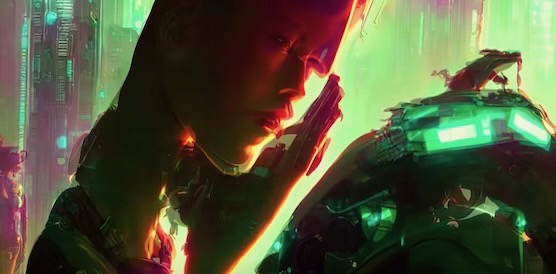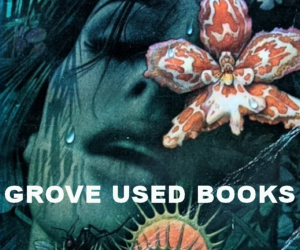
Everything with AI has grown exponentially this year, and this week we show you AI for animation using different techniques as well as AR, VR and voice cloning. It is astonishing that some of these tools are already a part of our creative toolset, as illustrated in our highlighted projects by GUNSHIP and Fabien Stelzer. Of course, any new toolset comes with its discontents, and so we cover some of those we’ve picked up on this past month too. It is certainly fair to say there are many challenges with this emergent creative practice but it appears these are being thought through alongside the developing applications by those using it… although, of course, legislation is far from here.
Animation
Text-to-image generator Stable Diffusion raised $100M in October this year and is about to release its animation API. On 15 November it released DreamStudio, the first API on its web platform of future AI-based apps, and on 24 November it released Stable Diffusion 2.0. The animation API, DreamStudio Pro, will be a node-based animation suite enabling anyone to create videos, including with music, quickly and easily. It includes storyboarding and is compatible with a whole range of creative toolsets such as Blender, potentially making it a new part of the filmmaking workflow bringing imagination closer to reality without the pain, or so it claims. We’ll see about that shortly no doubt. And btw, 2.0 has higher resolution upscaling options, more filters on adult content, increased depth information that can be more easily transformed into 3D and text-guided in-painting which helps to switch out parts of an image more quickly. You can catch up with the announcements on Robert Scoble’s Youtube channel here –
As if that isn’t amazing enough, Google is creating another method for animating using photographs, think image-to-video, called Google AI FLY. Its approach will make use of pre-existing methods of in-painting, out-painting and super resolution of images to animate a single photo, creating a similar effect to nerf (photogrammetry) but without the requirement for many images. Check out this ‘how its done’ review by Károly Zsolnai-Fehér on the Two Minute Papers channel –
For more information, this article on Petapixel.com‘s site is worth a read too.
And finally this week, Ebsynth by Secret Weapon is an interesting approach that uses a video and a painted keyframe to create a new video resembling the aesthetic style used in the painted frame. It is a type of generative style transfer with an animated output that could only really be achieved in post production but this is soooo much simpler to do and it looks pretty impressive. There is a review of the technique on 80.lv’s website here and an overview by its creators on their Youtube channel here –
We’d love to see anyone’s examples of outputs with these different animation tools, so get in touch if you’d like to share them!
AR & VR
For those of you into AR, AI enthusiast Bjorn Karmann also demonstrated how Stable Diffusion’s in-painting feature can be used to create new experiences – check this out on his Twitter feed here –
Made a quick AR inpainting experiment called We See!
— Bjørn Karmann (@BjoernKarmann) November 10, 2022
It is more a proof of concept showing how voice command, selection gesture, #stablediffusion and #AugmentedReality can come together to alter the reality around us. 🌲 + 🐘 pic.twitter.com/K0boJMknql
For those of you into 360 and VR, Stephen Coorlas has used MidJourney to create some neat spherical images. Here is his tutorial on the approach –
Also Ran?
Almost late to the AI generator party (mmm….), China has released ERNIE-ViLG 2.0 by Baidu, a Chinese text-to-image AI which Alan Thompson claims is even better than DALL-E and Stable Diffusion albeit using much a smaller model. Check out his review which certainly looks impressive –
Voice
NVidia has done it again – their amazing Riva AI clones a voice using just 30 minutes of voice samples. The application of this is anticipated to be conversational virtual assistants, including multi-lingual assistants and its already been touted as frontrunner with Alexa, Meta and Google – but in terms of virtual production and creative content, it is also possible it could be used to replace actors when, say, they are double booked or poorly. So, make sure you get that covered in your voice-acting contract in future too.
Projects
We found a couple of beautiful projects that push the boundaries this month. Firstly GUNSHIP’s music video is a great example of how this technology can be applied to enhance their creative work. Their video focusses on the aesthetics of cybernetics (and is our headline image for this article). Nice!
Secondly, an audience participation film by Fabien Stelzer which is being released on Twitter. The project uses AI generators for image and voice and also for scriptwriting. After each episode is released, viewers vote on what should happen next which the creator then integrates into the subsequent episode of the story. The series is called Salt and its aesthetic style is intended to be 1970s sci-fi. You can read about his approach on the CNN Business website and be a part of the project here –
— SALT (@SALT_VERSE) June 14, 2022
Emerging Issues
Last month we considered the disruption that AI generators are causing in the art world and this month its the film industry’s turn. Just maybe we are seeing an end to Hollywood’s fetish with Marvellizing everything or perhaps AI generators will result in extended stories with the same old visual aesthetic, out-painted and stylized… which is highly likely since AI has to be trained on pre-existing images, text and audio. In this article, Pinar Seyhan Demirdag gives us some thoughts about what might happen but our experience with the emergence of machinima and its transmogriphication into virtual production (and vice versa) teaches us that anything which cuts a few corners will ultimately become part of the process. In this case, AI can be used to supplement everything from concept development, to storyboarding, to animation and visual effects. If that results in new ideas, then all well and good.
When those new ideas get integrated into the workflow using AI generators, however, there is clearly potential for some to be less happy. This is illustrated by Greg Rutkowski, a Polish digital artist whose aesthetic style of ethereal fantasy landscapes is a popular inclusion in text-to-image generators. According to this article in MIT Technology Review, Rutkowski’s name has appeared on more than 10M images and used as a prompt more than 93,000 times in Stable Diffusion alone – and it appears that this is becasue data on which the AI has been trained includes ArtStation, one of the main platforms used by concept artists to share their portfolios. Needless to say, the work is being scaped without attribution – as we have previously discussed.
What’s interesting here is the emerging groundswell of people and companies calling for legislative action. An industry initiative has formed and is evolving rapidly, spearheaded by Adobe in partnership with Twitter and the New York Times called Content Authentication Initiative. CAI aims to authenticate content and is a publishing platform – check out their blog here and note you can become a member for free. To date, it doesn’t appear that the popular AI generators we have reviewed are part of the initiative but it is highly likely they will at some point, so watch this space. In the meantime, Stability AI, creator of Stable Diffusion, is putting effort into listening to its community to address at least some of these issues.
Of course, much game-based machinima will immediately fall foul of such initiatives, especially if content is commercialized in some way – and that’s a whole other dimension to explore as we track the emerging issues… What of the roles of platforms owned by Amazon, Meta and Google, when so much of their content is fan-generated work? And what of those games devs and publishers who have made much hay from the distribution of creative endeavour by their fans? We’ll have to wait and see but so far there’s been no real kick-back from the game publishers that we’ve seen. The anime community in South Korea and Japan has, however, collectively taken action against a former French game developer, 5you. The company used a favored artist’s work, Jung Gi, to create an homage to his practice and aesthetic style after he had died but the community didn’t agree with the use of an AI generator to do that. You can read the article on Rest of World’s website here. Community action is of course very powerful and voting with feet is something that invokes fear in the hearts of all industries.




3 Comments
It’s all happening so fast!! Good grief.
Yeah, every month its something new… but there’s still the same old challenge of figuring out the craft of what’s a good story (and for whom). So far, that remains a human choice (incl promo) but wonder for how long that will be the case.